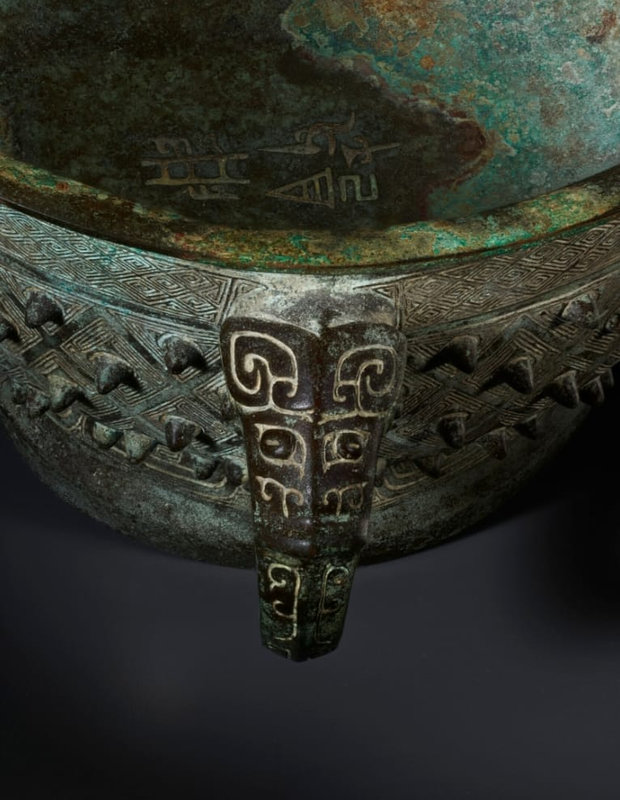A very finely cast bronze ritual food vessel and cover, gui, Late Shang dynasty, 11th century BC
Lot 717. A very finely cast bronze ritual food vessel and cover, gui, Late Shang dynasty, 11th century BC; 11 1⁄8 in. (28.1 cm.) wide across handles, cloth box. Price realised USD 226,800 (Estimate USD 200,000 – USD 300,000). © Christie's 2022
The vessel is raised on a tall foot encircled by a band comprised of kui dragons centered on narrow flanges. The body is decorated with a diamond-and-boss pattern below a band with panels of diamond frets centered on two sides by a small animal mask cast in relief and interrupted on the other two sides by a pair of handles issuing from bovine masks. The inscription cast on the interior of the vessel consists of a graph, shou followed by Fu Xin, Zu Ji (Father Xin, Grandfather Ji). The patina is of mottled greyish-green color.
Provenance: Bella and P. P. Chiu Collection, Hong Kong, by 1988.
Eskenazi, London.
Michael Goedhuis Ltd., London, 1998.
Literature: N. Barnard and Cheung Kwong-yue, Rubbings and Hand Copies of Bronze Inscriptions in Chinese, Japanese, European, American and Australasian Collections, Taipei, 1978, Vol. 7, no. 1387.
J. Rawson, The Bella and P.P. Chiu Collection of Ancient Chinese Bronzes, Hong Kong, 1988, p. 62, no. 19.
Note: This superbly cast gui with attractive pale greenish-grey patina compares closely with a gui with similar handles and similar decoration of pointed bosses set within a diamond-shaped grid, from the vicinity of the Gan He, Shaanxi Liquan Xian, illustrated in Wenwu ziliao congkan 3, 1980, pp. 28-31, pl. 4:2, and again by J. Rawson in Western Zhou Ritual Bronzes from the Arthur M. Sackler Collections, vol. IIB, The Arthur M. Sackler Foundation, Washington, D.C., 1990, p. 478, fig. 41.1. Also illustrated, p. 378, fig. 41.2, is another similar gui, but with more rounded bosses, which was said to have been found at Anyang. Another comparable gui, formerly in the collection of Chen Jieqi (1813-1884), and said to have been found in Shaanxi Qishan Xian, is illustrated by S. Umehara in Kankaro kikkin-zu, Kyoto, 1947, no. 1.17.
In the entry for the present gui in The Bella and P. P. Chiu Collection of Ancient Chinese Bronzes, Hong Kong, 1988, p. 62, J. Rawson notes, “As with the handles on the present gui, the handles on these Shang vessels often carry rather flat heads. In the early Zhou period, by contrast, comparable gui bore handles crowned by animal heads with horns flattened against the sides, rather than against the tops of the handles…”
Christie's. Important Chinese Ceramics and Works of Art, New York, 25 march 2022

/https%3A%2F%2Fprofilepics.canalblog.com%2Fprofilepics%2F1%2F0%2F100183.jpg)
/https%3A%2F%2Fstorage.canalblog.com%2F03%2F02%2F119589%2F96711876_o.jpg)
/https%3A%2F%2Fstorage.canalblog.com%2F11%2F31%2F119589%2F94773502_o.jpg)
/https%3A%2F%2Fstorage.canalblog.com%2F20%2F83%2F119589%2F94772815_o.jpg)
/https%3A%2F%2Fstorage.canalblog.com%2F26%2F72%2F119589%2F75604929_o.jpg)
/https%3A%2F%2Fstorage.canalblog.com%2F59%2F60%2F119589%2F26458628_o.jpg)








/image%2F1371349%2F20240406%2Fob_b23648_434058570-1644317966338216-88086167391.jpg)
/image%2F1371349%2F20240403%2Fob_6d5ae7_dp-28103-001.jpg)
/image%2F1371349%2F20240229%2Fob_8f31f9_431013694-1625286614908018-33034430839.jpg)
/http%3A%2F%2Fstorage.canalblog.com%2F79%2F20%2F119589%2F129837997_o.jpg)